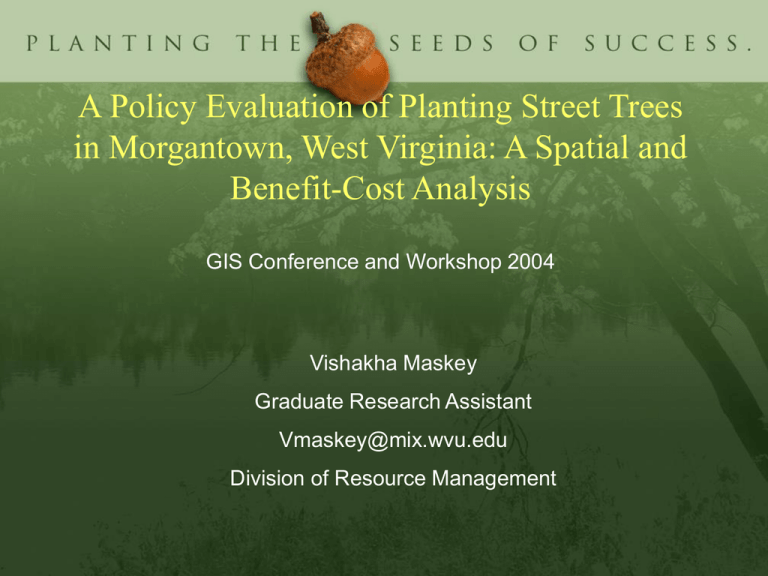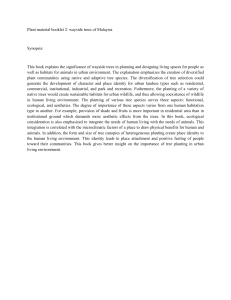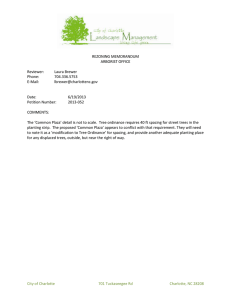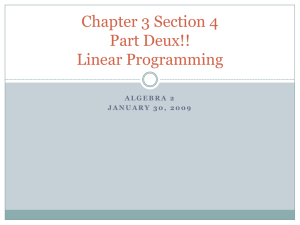A Policy Evaluation of Planting Street Trees Benefit-Cost Analysis
advertisement

A Policy Evaluation of Planting Street Trees in Morgantown, West Virginia: A Spatial and Benefit-Cost Analysis GIS Conference and Workshop 2004 Vishakha Maskey Graduate Research Assistant Vmaskey@mix.wvu.edu Division of Resource Management Background Information: • Urban Forests – Street trees, trees on the private property, and parks • Street Trees – Trees that are publicly owned – Are within 6 feet of the road Overview of Tree Benefits: Ecological and Health Benefits through: • Air pollution removal • Carbon reduction, Oxygen production • Biodiversity maintenance • Stormwater management Benefits cont. Social and Economic Benefits through: • Increase in aesthetic value (property prices) • Replacement value • Psychological value • Lower crime rate • Traffic safety Overview of Tree Costs: Social/Economic Cost Ecological cost • Sidewalk and property damage • Hydrocarbon production • Maintenance cost • Water consumption • Planting and replacement cost • Displacement of native species • Pollen allergies Problem Statement: • Increased development and population pressure • Decreasing tree cover • Lack of planting and proper maintenance initiative due to unobserved benefits in the market • Investment decisions dependent upon costs of implementation Why Morgantown, West Virginia? • Decreasing aesthetics of the city • Air quality problems • Initiatives from different governmental and nongovernmental sectors • Many plantable spaces that need cost- effective decision on plantings Objective of the Research: • Develop an infrastructure for planting street trees; • Facilitate decisions on future plantings with reliable monetary information on costs and benefits; • Generate a valid argument on planting decision. Conceptual Framework: Tree number Costs -Infrastructure - Planting -Maintenance -Removal Benefits Energy savings Pollution control Runoff Control Carbon Dioxide Water Conserved Benefit-Cost Analysis Net Benefits B/C Ratios IRR Research Method Application: • Spatial Analysis to develop infrastructure • Benefit- Cost analysis to facilitate policy decisions Spatial Analysis: Categorized all streets in Morgantown into suitability Index with respect to soil type, slope and land cover: – Most suitable – Moderately suitable – Unsuitable Benefit-Cost Analysis • Methodology: NPV= 40 (Bt-Ct)/(1+i)^t i t0 – Where NPV = Net Present Value, Years (t) = 0 …….40 – Discount Rate (i) = 7 %, – B = Total Benefit – C = Total Cost Benefit and Costs Per Year: • Air Quality Benefits = $16 per tree • Stormwater runoff reduction = $6.76 per tree • Carbon dioxide reduction = $5 per tree • Aesthetic Benefit = $17 per tree • Energy Savings =$10 per tree • These estimates are lower bound of previous researches done my McPherson in California. • Fixed costs – Planting Costs =$500 per tree – Sidewalk and Curb Cost =$1,127 which includes equipment, material and labor cost • Variable cost – Maintenance Costs = $9.61 per tree • Cost estimates are from Mr. Bill Rumble (City of Morgantown) and Dr. Cummings (Morgantown Tree Board) Estimates: • The net benefit per tree = $ 54.76 • Benefit-cost ratio = 2.25:1 • Net Present Value (NPV) of $20,491.30 • IRR (Internal Rate of Return) of 12%. Conclusions: • The accounting of benefit and costs of planting 20 new trees seems feasible; • Positive net benefit should serve as argument for funding; • The costs and benefits are dynamic and projections may not be accurate. Policy Recommendation: • Better City ordinance • Subsidies or payment for maintenance and replacement • Incorporating Citizen forester program – Training and information • More reliable benefit quantification required using computer based programs such as STRATUM, which quantifies benefits of street trees. Thank you for your attention!



